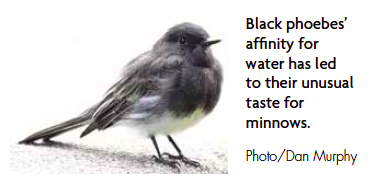The only flycatcher regularly seen in the neighborhood is the black phoebe. Indeed, black phoebes reside with us throughout the year.
Known as the photographer’s friend, they are bold and approachable. Conveniently, they perch and sally after flying insects at eye level. They draw attention with a downward wag and fanning of the tail and a regularly repeated short call.
“Phoebe” is onomatopoeic; it is taken from the call of the related eastern phoebe. The black phoebe’s call is a buzzy “ptziee.”
Male and female black phoebes look the same. The only variant touch of color they display is rusty or cinnamon bars on the wings and feather fringes of juveniles. The young are raised to fledglings in nest sites that are often reused by the same pair of parents over the five or six breeding seasons of their life span. The nest sites are selected by the female from possibilities suggested by the male during courtship displays.
The nests are constructed on walls or other vertical surfaces, preferably under an overhang. Nests are constructed by flinging pellets of mud that adhere to the surface and gradually build up into a cup that is lined with plant material. The one to six eggs are usually brooded by the female. Both parents feed the young.
The requirement of nearby mud for nest construction constrains the suitable breeding areas for black phoebes. Unlike most birds, their breeding range and success has increased as a result of human development.
Black phoebes are insectivores, with a usual diet of bees and wasps, flies, beetles, damselflies, dragonflies and spiders. However, their affinity for water has led to one unusual diet item – minnows.
• • •
If you see a bird that you cannot name, there are a couple of free apps and programs that can help with identification. The Merlin Bird ID smart phone app, by the Cornell Lab of Ornithology, is easy to use. After a few simple multiple- choice questions (location, date seen, size, colors and behavior), Merlin provides a selection of photos of possible answers. So if you input, sequentially, “Sacramento”, “today”, “sparrow sized”, “black” and “white”, and “in trees or bushes”, the fourth photo that pops up is a black phoebe.
Often, you can hear a bird singing plainly, but never get a good look at it. Birds singing, calling or even drumming on a tree can often be identified by BirdNet, another free app (or computer download) from Cornell Lab. If you record a clear snippet of vocalization with your smart phone, the BirdNET app will upload it, quickly process the sound and return a list of likely prospects
